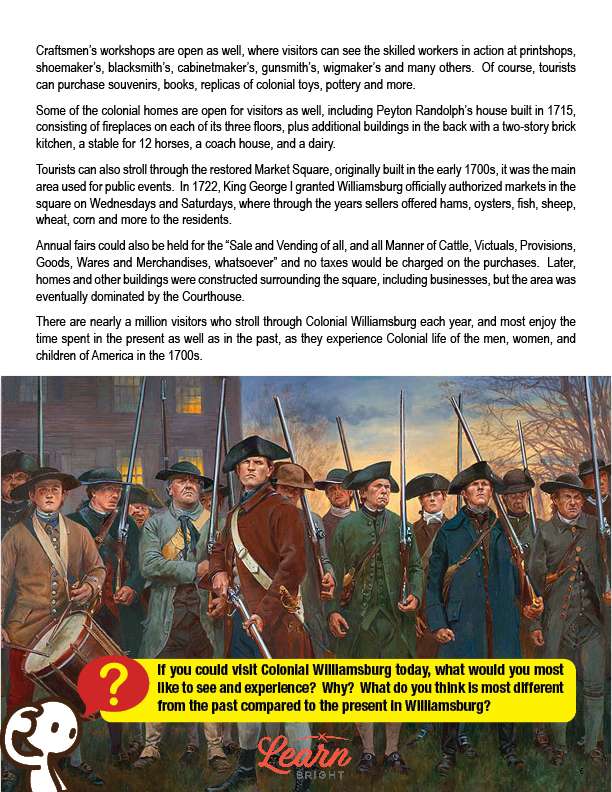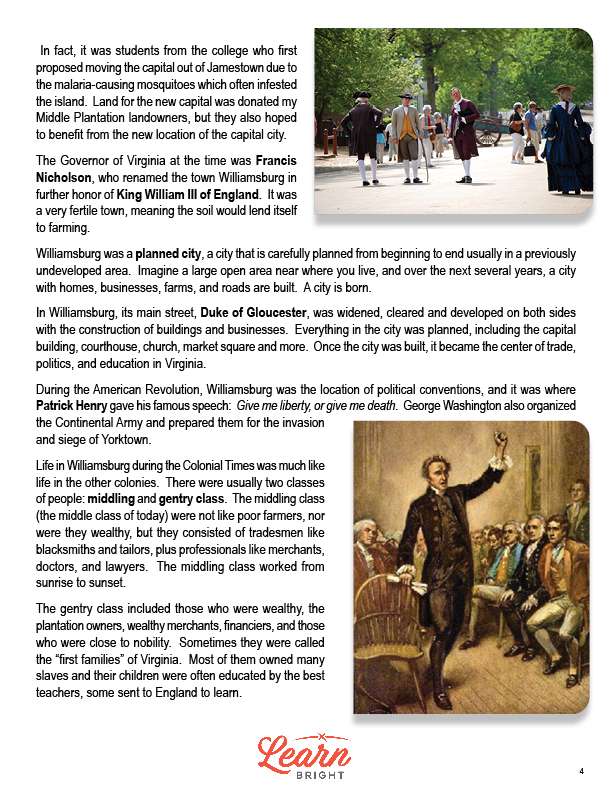Description
What our Colonial Williamsburg lesson plan includes
Lesson Objectives and Overview: Colonial Williamsburg introduces students to Colonial Williamsburg, its importance to America in the 1700s and its significance to America today. Many students may have heard of Williamsburg, but may not know its history and role during Colonial Times. At the end of the lesson, students will be able to identify and locate Colonial Williamsburg and explain its importance in the history of America, as well as its significance today. This lesson is for students in 3rd grade, 4th grade, 5th grade, and 6th grade.
Classroom Procedure
Every lesson plan provides you with a classroom procedure page that outlines a step-by-step guide to follow. You do not have to follow the guide exactly. The guide helps you organize the lesson and details when to hand out worksheets. It also lists information in the orange box that you might find useful. You will find the lesson objectives, state standards, and number of class sessions the lesson should take to complete in this area. In addition, it describes the supplies you will need as well as what and how you need to prepare beforehand. To prepare for this lesson ahead of time, you can pair students and prepare the supplies for the activity and copy the handouts.
Options for Lesson
Included with this lesson is an “Options for Lesson” section that lists a number of suggestions for activities to add to the lesson or substitutions for the ones already in the lesson. One optional adjustment to the lesson activity is to have students create a planned colonial city instead of a modern city. You can have your students create 3D planned cities with the available supplies, and have students vote on the best designed city, best named city, and more. For an additional activity, you can invite a historian to speak to your class about Williamsburg. Finally, you can let your students use the internet to find interactive sites that they can use to take a virtual tour of Colonial Williamsburg.
Teacher Notes
The teacher notes page includes a paragraph with additional guidelines and things to think about as you begin to plan your lesson. This page also includes lines that you can use to add your own notes as you’re preparing for this lesson.
COLONIAL WILLIAMSBURG LESSON PLAN CONTENT PAGES
Colonial America
The Colonial Williamsburg lesson plan includes four content pages. The lesson begins by explaining that the United States had 13 original colonies: New Hampshire, Massachusetts, Connecticut, Rhode Island, New York, New Jersey, Pennsylvania, Delaware, Maryland, Virginia, North Carolina, South Carolina and Georgia. The first colony was Virginia, which John Smith and the London Company founded in 1607.
Jamestown, Yorktown, and Williamsburg, which make up the Historic Triangle in Virginia, were three of the most important towns in America during Colonial Times. There were all colonial communities on the Virginia Peninsula, bordered by the York River to the North and the James River to the South.
The first permanent English settlement was Jamestown. It was the first capital of Virginia. Yorktown was where General Cornwallis surrendered to George Washington during the American Revolution in 1781. Williamsburg, the third city of the triangle, became the new capital of Virginia when the statehouse in Jamestown burned down in 1698. They chose it because of Williamsburg’s position on higher ground and away from waterways.
Early railroads could not reach Williamsburg because of its location, but it was still the state capital for 81 years. George Washington, Thomas Jefferson, Patrick Henry, James Monroe, and more met there to discuss the future of the United States.
During the American Revolution, Thomas Jefferson, then Governor, moved the state capital to Richmond, located about 55 miles west. Richmond’s location was more central and easily accessible to the western part of the state, and the British would be less likely to attack it during the war. For 81 years, Williamsburg was one of the most important cities in Colonial America. Today, they’ve restored it and people can visit it to see how people lived during Colonial Times in the 1700s.
The Past
Before Williamsburg got its current name in 1699, they called the area Middle Plantation and it housed the College of William and Mary. Lots of famous people, like Jefferson, Monroe, John Marshal, and Peyton Randolph, the first president of the Continental Congress, attended the college. They named it after King William III and Queen Mary II, English royals.
Students from William and Mary first proposed moving the capital out of Jamestown because of mosquitoes which carried malaria. Middle Plantation landowners donated the land for the capital, hoping to benefit from its new location.
Francis Nicholson, the Governor of Virginia at the time, renamed the town Williamsburg in honor of King William III of England. The soil was very fertile and would lend itself well to farming. It was a planned city, which means that they carefully planned it out. They usually built them in large, open areas, where they could plan out the locations of homes, businesses, farms, and roads.
First, they widened, cleared and developed the main street in Williamsburg, Duke of Gloucester. They planned out the capital building, courthouse, church, market square, and more. After they built the city, it became Virginia’s center of trade, politics, and education.
Williamsburg housed political conventions during the American Revolution, and Patrick Henry gave his famous “Give me liberty, or give me death” speech there. George Washington organized the Continental Army and got them ready for the siege of Yorktown there.
Life in Williamsburg
During Colonial Times, life in Williamsburg was like it was in the other colonies. There were two main classes, the middling class and the gentry class. The middling class, like the middle class of today, were tradesmen and professionals, like blacksmiths, tailors, merchants, doctors, and lawyers. They were not poor like the farmers, but were not wealthy either. The gentry class were the wealthy plantation owners, merchants, financiers, and nobility. Some people called them the “first families” of Virginia, and many of them owned slaves. They educated their children, and even sent some to England to learn.
Farmers lived and worked on small farms, with their families or slaves doing the labor. Some free black people owned property, though they didn’t have the same rights as the white people. African-American slaves worked as field hands on tobacco fields or as house servants. Men, women, and children worked all day long, from sunrise to sunset. House servants cooked and did laundry and other chores. They did not have time to themselves.
During this time, they educated the children of wealthier families. The children of the middling and gentry classes may have had some free time for board games, puzzles, cards, and other games. All in all, life here was a lot like it was in the other colonies at the time.
The Present
Today, we often call the town of Williamsburg “Colonial Williamsburg” because it offers visitors a look into the past. The town is like a living history museum and is a historic landmark. The street Duke of Gloucester still exists and they’ve closed the main streets to cars during the day. They allow walkers, joggers, bicyclists, skaters, and animal-drawn vehicles to help preserve a sense of life as it was in the 1700s.
They’ve restored many of the surviving buildings from the 1700s and rebuilt some of the missing structures on their original sites. Most of the town is open for tourists and visitors. People can visit other locations, like craftsmen’s workshops, where they can see skilled workers in action. These include printshops, shoemakers, blacksmiths, cabinetmakers, gunsmiths, wigmakers, and more. Tourists can also buy souvenirs, books, replicas, and more.
You can also visit some colonial homes, like Peyton Randolph’s house, which they built in 1715. Each floor had three floors, and there is another building in the back with a kitchen, a 12-horse stable, a coach house, and a dairy.
Tourists can also visit Market Square, which they originally built in the early 1700s and was the main are for public events. King George I authorized markets on Wednesdays and Saturdays in 1722. During these markets, sellers sold hams, oysters, fish, sheet, wheat, corn, and more. They also held untaxed annual fairs. As time went on, the square grew to include homes and other buildings, like the Courthouse.
Almost a million people visit Colonial Williamsburg every year. Most people get to see what life was like in the past and what life is like now.
Key Terms
Here is a list of the vocabulary words students will learn in this lesson plan:
- John Smith: Founded Virginia along with the London Company
- Historic Triangle: Includes the towns of Jamestown, Yorktown, and Williamsburg
- Jamestown: First permanent English settlement and capital of Virginia
- Yorktown: Place where Cornwallis surrendered to Washington
- Middle Plantation: The previous name of the area that is called Williamsburg today
- Peyton Randolph: First president of the Continental Congress
- Francis Nicholson: Governor who renamed the town Williamsburg
- King William III of England: The town of Williamsburg is named in his honor
- Planned city: An undeveloped area carefully planned for living
- Duke of Gloucester: The main street of Williamsburg
- Patrick Henry: Known for his “give me liberty, or give me death” speech
- Middling class: Consists of tradesmen like blacksmiths, tailors, professionals
- Gentry class: Wealthy plantation owners, merchants, financiers
COLONIAL WILLIAMSBURG LESSON PLAN WORKSHEETS
The Colonial Williamsburg lesson plan includes three worksheets: an activity worksheet, a practice worksheet, and a homework assignment. You can refer to the guide on the classroom procedure page to determine when to hand out each worksheet.
PLANNED CITY ACTIVITY WORKSHEET
Students will work with a partner to complete the lesson activity. Each pair will create an updated, modern planned city. They will use colored pencils, rulers, scratch paper, graph paper, and final copy paper to draft and create a final version of their plans. They should consider many things while creating their city, such as the fact that people should be able to live, work, shop, and play there; children need schools and colleges; people need different kinds of transport, like cars, buses, and bicycles; visitors will come to the city; and that they must choose a name.
Each pair will make sure that the scale and proportions of the city make sense. They should label businesses and buildings, and include street names. Students should look at the plans for Williamsburg and think about including some of those buildings or features. Once they’re finished, they will share their planned city with the class.
Students may work either alone or in groups for this activity if you’d prefer.
MATCHING PRACTICE WORKSHEET
For the practice worksheet, students will match the information about Colonial Williamsburg with the terms provided.
COLONIAL WILLIAMSBURG HOMEWORK ASSIGNMENT
The homework assignment asks students to answer twelve questions related to Colonial Williamsburg, to test their understanding of the lesson material. They will also explain what Patrick Henry meant when he said “Give me liberty or give me death.”
Worksheet Answer Keys
This lesson plan includes answer keys for the practice worksheet and the homework assignment. If you choose to administer the lesson pages to your students via PDF, you will need to save a new file that omits these pages. Otherwise, you can simply print out the applicable pages and keep these as reference for yourself when grading assignments.









